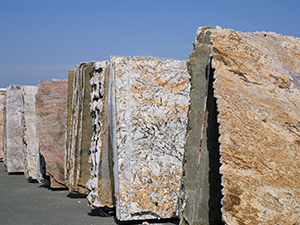
Natural stone countertop selection requires a bit of due diligence by consumers, from preliminary research and measurements to selection and the final slab inspection. When it comes to slab inspection, the most important thing to remember is that what you see is what you get. Here’s what you need to know before you make a final decision on a slab purchase.
Naturally Occurring Stone Features
Sometimes during slab inspection, clients find what appears to be small imperfections, such as fissures or spots. These naturally occurring stone features have no effect on the structural integrity of the slab.
Fissures, which are similar in appearance to a crack, are a result of geological or environmental forces, crystallization of minerals, and other conditions, whereas cracks are a result of man-made stresses, such as transport from the quarry to the fabricator or from fabricator to a residence or commercial facility.
Spots on a slab, like shade variation, veining, and other natural characteristics, are a common feature of natural stone. Naturally occurring spots are not stains, which are a result of something spilled on stone.
If the slab you intend to purchase has one of these stone features, you have a few options. You can embrace the fact that your countertop material is a completely unique product of nature and appreciate its perfectly imperfect appearance, you can select a different slab, or you can consult with your fabricator on other options.
Your Countertop Layout
Depending on the layout of the countertop design, fabricators may be able to cut slabs for inconspicuous placement of a portion of the slab. Because your countertop will need space cut out for the sink and faucets, it may be possible to avoid it altogether so that the spot or fissure ends up in the scrap material. If you have an area you want to avoid, ask for a layout to determine whether this is an option for you.
Once you find a slab you love, inspect it carefully to be sure it is the most appropriate choice for your countertops.
